
www.pacifictenders.com JANUARY - MARCH 2023 ISSUE 12



PT your next project here www.pacifictenders.com FIND
Published by Adkonect PNG PO Box 1954



Port Moresby, PNG www.adkonect.com.pg
Founder Publisher
Mr. Rodney Rupokets rodney@pacifictenders.com
Business and Marketing Director

Ms. Namoi Kaluae
Editor
Mr. Douglas Saefoa (Solomon Islands)
Contributing Writers
Mr. David Spring (Sydney, Australia)
Advertising Enquiries
contact@pacifictenders.com sorbie@pacifictenders.com
www.pacifictenders.com
S.I +677 38229
PNG +675 75971524
PNG +675 75923057
Editorial Enquiries email: media@pacifictenders.com or PNG Contact In country Marketing/Advertising

Mr. sorbie Pandiruo
Distribution PT-Magazine is distributed via a Digital Copy accessed from the pacifictenders.com Platform reaching all PT Subscriber Companies and printed copies distributed to Government Agencies, Hotels, Retail and Hardware Supermarkets in Honiara and Port Moresby. Relying on the support of our peers in the Construction and Infrastructure sectors to help this initiativ e grow.
09 ADB VISITS NEW USP CAMPUS IN SOLOMON ISLANDS CONTENTS 08 07 COVER STORY TENDER PRICE INDEX: SOPHISTICATION OR SOPHISTRY? 05 10 REEVES REGIONAL SUPPORT TO WASH PROJECTS USD$ 170 MILLION OPPORTUNITY UPGRADED AIRPORT UNVEILED 12 THE PROJECT FOR THE IMPROVEMENT OF THE HONIARA INTERNATIONAL AIRPORT 15 IUU FISHING ECHOED AT THE HONIARA PNA SUMMIT
Sophistication or Sophistry?
DAVID SPRING PT COLUMNIST Sydney, Australia

FROM Ghana to Singapore, it seems everyone has had a go at creating a tender price index (TPI). As yet, no Pacific countries maintain or use one. Is that a missed opportunity? Is a TPI a mark of industry maturity or a price control mechanism? Would it be an unnecessary burden producing little benefit? But firstly, what even is a TPI?
A TPI is an index which shows whether tender prices are trending upwards or downwards. It is a lagging indicator of the rise and fall of tender pricing, measured for the previous period, usually a quarter of a year. Unlike a consumer price index (CPI), which is widely used and reported in all countries, a TPI does not have a standard ‘basket of goods’ to compare the cost of. Every tender is unique – scope, risks, location, sectors – making comparison difficult.
This is usually overcome by excluding small projects, excluding tenders that don’t use standard rates or schedules and excluding specialist items. Some jurisdictions publish a series of factors to adjust the standard index number to suit a specific location or project function. Even if there was a standard list of items that make up the TPI, considering the volume of contracts each quarter, sample size in most Pacific countries would be very small.
Looking back to look forward
While a TPI gives you an insight into the past, there are a lot of things that a TPI won’t tell you. Most obviously, it
doesn’t tell what tender prices will be in the next quarter! Academics and statisticians have tried to find correlations between TPI and other statistical indicators to try to forecast the direction of a TPI, without much success. The number of variables that go into producing the index and market instability makes correlation elusive. Even accepting TPI for what it is (history, not forecast), there are several practical difficulties with creating and maintaining a reliable TPI: where will the data come from, who will do the work to keep it up to date and where will the data be stored for future use. Undertaking this task –defining the basis of TPI data, collecting it, collating it and preparing it for issue each quarter – is daunting. It could be argued that national statistics offices and infrastructure ministries already have enough to do with their limited funds, than worry about another statistical index. As the level of difficulty increases, the likelihood of late issue of the data also increases. Historic trends are still of some value but an outdated TPI would begin to lose relevance with each month it is late.
What benefit?
One area where TPIs are often touted as useful is in the production of project budgets early on in the design development phase. Government ministries and donors typically use an engineer’s estimate as the basis of their budget for approval. When these numbers turn out to be different to the actual tender prices, blame is laid on
TENDER PRICE INDEX:
COVER STORY INFRASTRUCTURE DEVELOPMENT / INDUSTRY > www.pacifictenders.com 5
the poor consultants who were tasked with predicting the future. A TPI is intended to assist these client-side engineers and quantity surveyors in the fools errand of producing cost estimates for projects.
TPIs provide insight to the past and the possible direction of future pricing.
But other factors such as market volatility, economic downturns, materials supply and demand, time to contract award and political uncertainty (or a global pandemic!) can also affect any project and they factor into tender prices.
A TPI would just be another voice in that chorus of factors and is unlikely to be decisive. Robust budgets need calibrated and risk-based contingencies added to the base cost estimates, not simplistic indices or percentages.
Why TPI?
In reality, each consulting firm or individual consultant develops their own set of numbers which function for them as a TPI. Past projects, bills of quantities, rates from other projects, reports and consultants, collected across years, to form a rates database used for producing estimates. Tender prices reflect contractor’s opinions about the future costs of labour and materials and their expectations of the
market’s competitive status. Contractors will undertake their own such analysis regardless of the existence of a TPI. A TPI is a mark of a mature industry and requires sophisticated data collection apparatus. Its time may come for the Pacific but right now, there are bigger fish to fry.

About the Author
David is an experienced engineer, with over 20 years experience in construction, design and international development. David has been working in Solomon Islands and Vanuatu as a team leader for the past six years, specifically on road and bridgeworks. He worked on intraMinistry roles at the Ministry of infrastructure Development (MID, Solomon Islands) and led the Cyclone Pam road reconstruction project in Vanuatu, understanding donor requirements and how development projects are procured and delivered. Continuing as a Team leader for MID and with some corporate responsibilities for Cardno, David seeks to deliver equitable access for communities, which generate social and economic benefits.
JANUARY - MARCH 2023 / ISSUE 12
USD$ 170 Million Opportunity
Government Commits to USD$170 Million Creating More Employment Opportunities
THE SOLOMON Islands Government has recently signed an agreement with China Civil Engineering Construction Corporation (CCECC) for the Maritime Component of the Land and Marine Connectivity Project (LMCP). This project aims to improve transportation networks and infrastructure in the Solomon Islands, with a budget of USD 170 million secured from the Asian Development Bank.
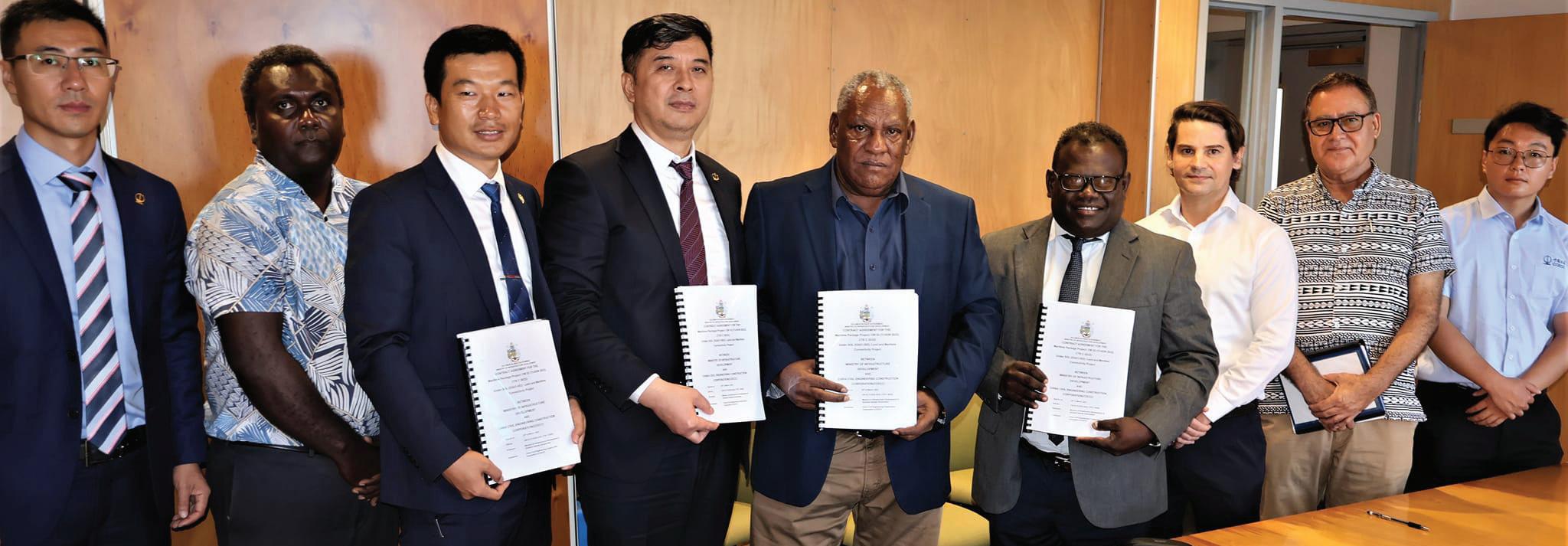
The Maritime Component specifically involves the rehabilitation of the Honiara International SeaPort, as well as the construction of the Honiara Domestic Seaport and two provincial seaports. Additionally, the LMCP includes a land component that will improve existing road networks.
The contract for the land component was signed earlier this year, and preparatory work is already underway.
The Solomon Islands Government, through the Ministry of Finance, executed the project signing, with the
Ministry of Infrastructure Development to be the key implementing agency.
Once complete, the project aims to improve connectivity, efficiency, and disaster resilience of transportation networks, as well as improving access to education, health, and social service facilities. It is also expected to provide increased opportunities to local businesses and improve the overall wellbeing of the people of the Solomon Islands.
This project is a significant milestone for the Solomon Islands Government, as it demonstrates their commitment to improving infrastructure and connectivity throughout the country.
The government has been working closely with CCECC and the Asian Development Bank to ensure the project's success, and they look forward to seeing the positive impacts it will have on the people of the Solomon Islands.
INFRASTRUCTURE DEVELOPMENT / INDUSTRY > www.pacifictenders.com 7
Permanent Secretary of the Ministry of Infrastructure Development, Stephen Maesiola and the Permanent Secretary of the Ministry of Finance and Treasury, McKinnie Dentana, along with representatives from China Civil Engineering Construction Corporation (CCECC) and the Asian Development Bank (ADB), pose for a photo after signing the agreement for the Maritime Component of the Land and Marine Connectivity Project.
Reeves Envico Regional Support to WASH projects



Reeves Envico is proud to support World Water Day by recognizing the importance of providing safe and sanitary water supplies to communities in Australia and the Pacific. As part of our commitment, we have actively pursued water and waste-water treatment projects in the region, working with local water authorities and funded by the Asian Development Bank and World Bank.

Our core expertise in delivering potable water and wastewater treatment plants has helped to improve the health of people in the region by providing clean, safe drinking water. Through our partnership with Osmoflo, we are delivering the large-scale South Tarawa desalination plant, with an estimated capacity of up to 6,000 m3/day as demand requires. We are also delivering water supply network infrastructure upgrades, which will reduce leakages and ensure all residents have access to clean drinking water. Our work on the Auki Water Supply Improvement Project with Solomon Islands Water Authority has contributed to
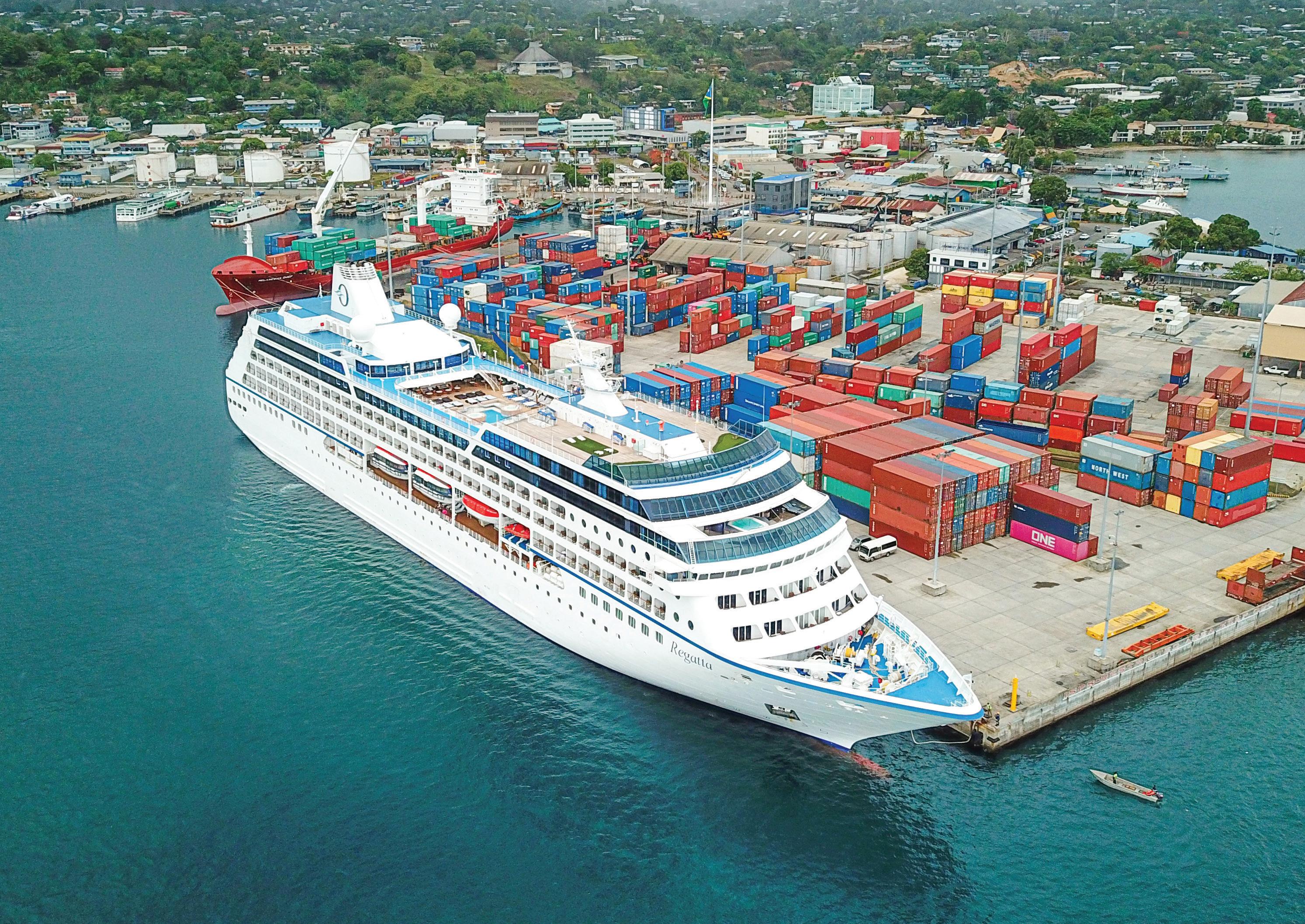
water safety and hygiene for over 7,000 people through the supply and construction of a 1 ML water tank, interconnecting transfer lines, and pump stations. With our water specialist team's solid experience in the Solomon Islands, we have made significant contributions to providing water sanitation and hygiene in the Pacific region.
As Drouin's population grows, there is a need to expand the capacity of the existing wastewater treatment plant. Reeves Envico, in partnership with Icon, has recently completed the $55-million Drouin Wastewater Treatment Plant Upgrade. This new mechanical treatment plant on the existing site on Settlement Road, in collaboration with Gippsland Water, will ensure a more flexible and robust wastewater treatment facility that delivers sustainable and affordable wastewater treatment to the residents of Drouin. We are committed to delivering safe and sustainable water solutions that improve the quality of life for communities throughout the Pacific region.
JANUARY - MARCH 2023 / ISSUE 12
PROUD HOST OF THE 45th PACIFIC MARITIME TRANSPORT ALLIANCE CONFERENCE 11th - 13th July 2023
Community Building winner 2022
www.sipa.com.sb
ADB VISITS NEW USP CAMPUS IN SOLOMON ISLANDS


THE ASIAN Development Bank (ADB) recently led a media tour of the expanded campus of the University of the South Pacific in Honiara on March 16th. The project, funded by a $15.4 million concessional loan and a grant of $1.5 million from the ADB-administered Clean Energy Fund, is part of the Higher Education in the Pacific Investment Program. This new campus, located next to the King George VI School, will provide students with better access to higher education, training, and vocational opportunities.
ADB’s Solomon Islands Pacific Country Office’s Unit Head, Elmar Elbling, stated that “this site visit is the opportunity to witness first-hand the great progress of this important project that will provide Solomon Islands’ growing youth population with access to quality education and training. We are delighted to partner with USP and the Government of Solomon Islands on this initiative.”
The expanded campus features additional teaching and education spaces and faculty and administrative facilities. It also provides full disability access to campus facilities and a 600kW roof-top solar-powered system that will contribute to the campus’ energy needs. The campus was designed with gender-friendly designs, such as the creation of safe and secure ICT learning hubs with
sanitation facilities for both women and men. USP Deputy Vice-Chancellor of Education, Jito Vanualailai, said that “this is yet another milestone of USP and ADB’s long-term partnership in the Pacific. The upgraded campus, with its state-of-the-art facilities, will provide students with better access to academic, training, and vocational opportunities.”
The project will support an anchor student program in public health, as well as a range of undergraduate and postgraduate courses. It will enhance ICT-based education, improve student support services, and help strengthen the university’s governance and management. Around 100 local workers are working on the project, and the construction of the campus is expected to be completed by mid-2023.
ADB is committed to achieving a prosperous, inclusive, resilient, and sustainable Asia and the Pacific while sustaining its efforts to eradicate extreme poverty. Established in 1966, it is owned by 68 members, with 49 from the region. The investment in the new campus is an essential step towards achieving this goal by providing better access to higher education and training for students in the Pacific.
INFRASTRUCTURE DEVELOPMENT / INDUSTRY > www.pacifictenders.com 9
Upgraded Airport Unveiled
Solomon Islands Takes Delivery of completed Honiara International Airport upgrades
THE GOVERNMENT of Solomon Islands took delivery of a new international terminal on March 15th, thanks to the government and the people of Japan. Although smaller than the old terminal, the new one is cleaner and less complicated to navigate, with important areas such as the security screening area and the immigration section being easier to identify. The new terminal includes a large departure area, duty-free shops, a business lounge area, a VIP lounge, and several cafeterias.
In his speech as the guest of honor, Prime Minister Manasseh Sogavare thanked the government and the
people of Japan for the wonderful gift. PM Sogavare stated that the construction of the new terminal had been a long time coming and that it would address important areas such as increasing efficiency, reducing risk to facilities, and improving the safety of the traveling public and aircraft.
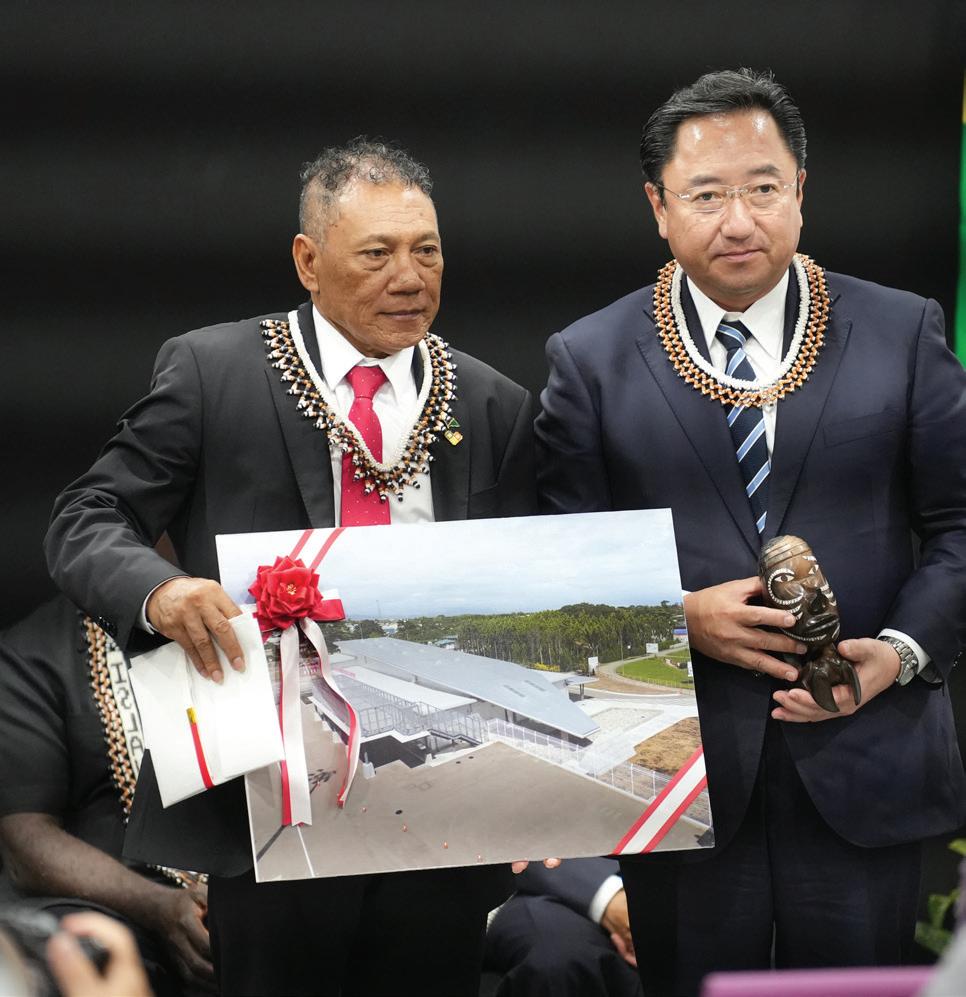
The Prime Minister went on to say that the real test of the new terminal would be during the Pacific Games in December this year when thousands of athletes and officials will depart. PM Sogavare also highlighted that the government is always committed to tourism

JANUARY - MARCH 2023 / ISSUE 12
Above: Prime Minister Manasseh Sogavare, Government officials and officials from the Embassy of Japan.
Below: Minister of Communication and Aviation Hon. Peter Shanel and an official from the Japanese Embassy in Honiara.
www.pacifictenders.com < 10
development, and the hope is that the Ministry of Communication and Aviation will be able to manage passengers and cargo effectively.
PM Sogavare further stated that with increased airport efficiency, Honiara International Airport would be promoted as a destination within the region.
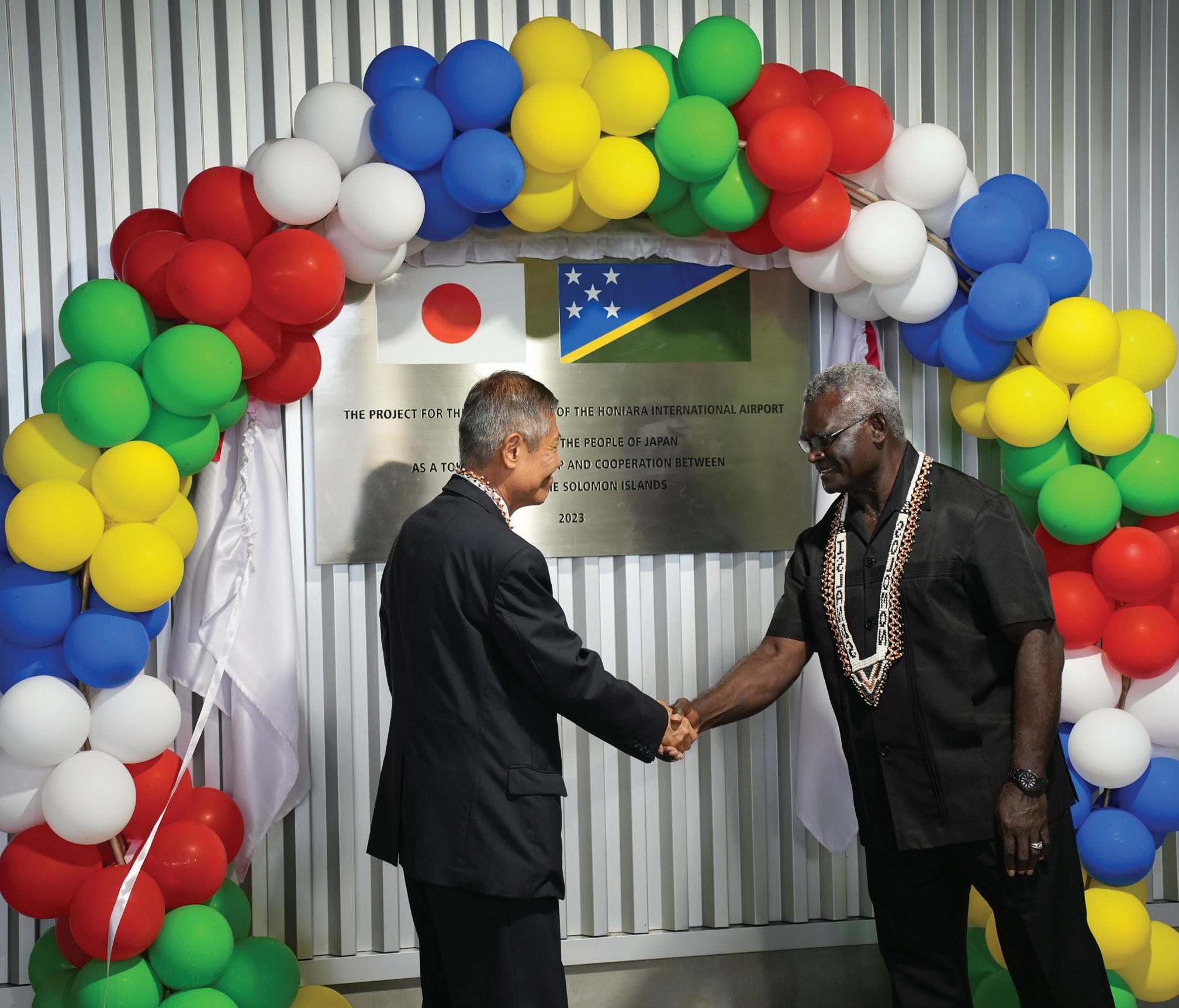
The Prime Minister also expressed that the Democratic Coalition Government for Advancement is always ambitious in its plans and visions. To cater to the plan to tap the huge Asian market, the current Honiara International Runway must be extended. However, if the runway is not extended, then consideration must be made to building a bigger international airport in another province.
The Prime Minister added that the country's population is one of the fastest-growing in the Pacific region and that by 2030, the country's population will be second
to Fiji. In addition, the increasing number of seasonal workers traveling to Australia and New Zealand means that infrastructure must be able to accommodate this growth.
PM Sogavare thanked the government and the people of Japan for their assistance in addressing connectivity in the transport sector.
“The increasing assistance by Japan in the Transport Sector is a very clear sign of strength of partnership between our countries and we hope that our partnership will continue to grow,” the Prime Minister added.
The Prime Minister further expressed that the development of the transport sector is crucial to the development and that DCGA will continue to work with the government of Japan and other development partners to develop the sector.
The Japanese Ambassador His Excellency Mr. Yoshiaki Miwa and the Prime Minister of Solomon Islands Hon. Manasseh Sogavare at the Commemorative Plaque Unveiling Ceremony.
INFRASTRUCTURE DEVELOPMENT / INDUSTRY > www.pacifictenders.com 11
Japanese Grant Aid
THE PROJECT FOR THE IMPROVEMENT OF THE HONIARA INTERNATIONAL AIRPORT
Project Objectives
To Improve Safety and Convenience of the Airport
To Cope with Future Growth of Air Traffic Demand
To Improve the Resilience of Airport Facilities against Natural Disaster
To Contribute to Socio‐Economic Development of the Solomon Islands
Project Scope
Rehabilitation of the Existing International Apron and Taxiway
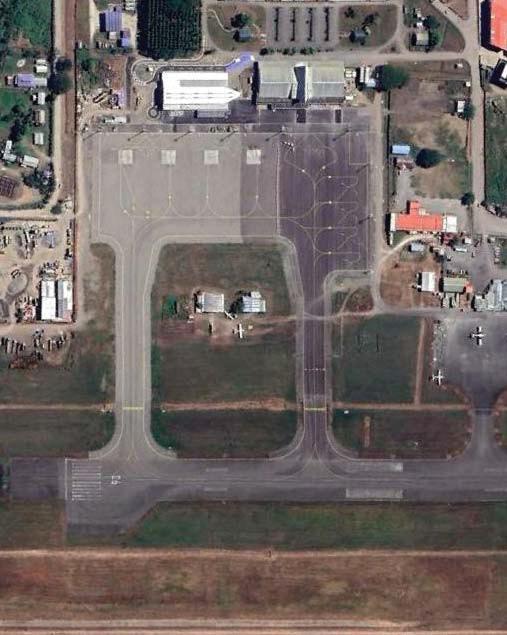

Expansion of the Apron and Construction of the New Taxiway
Installation of New Airfield Lightings
Construction of the New International Departure Terminal Building
Renovation of the Existing International Terminal Building
Construction of the Flood Protection Facilities
/ Renovation of Utility Buildings

Project History
16th May 2018
15th June 2018
29th June 2018
15th November 2019
1st December 2019
February 2023 (Expected)
Signing of Exchange of Notes (E/N)
Signing of Grant Agreement (G/A)
Signing of the Consultant Agreement
Signing of the Contract for Construction
Commencement of Construction
Completion of the Project
Note: Construction period has been extended for approximately 10 months due to suspensions caused by COVID‐19 and unrest in Honiara.
Before
⑤ ④ ③ ② ① ⑦ ⑥ As of July 2022
the Project (2017)
Construction
1 2 3 4 5 6 7 www.pacifictenders.com < 12
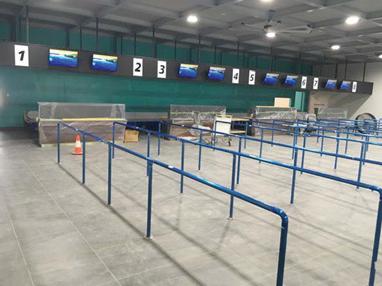




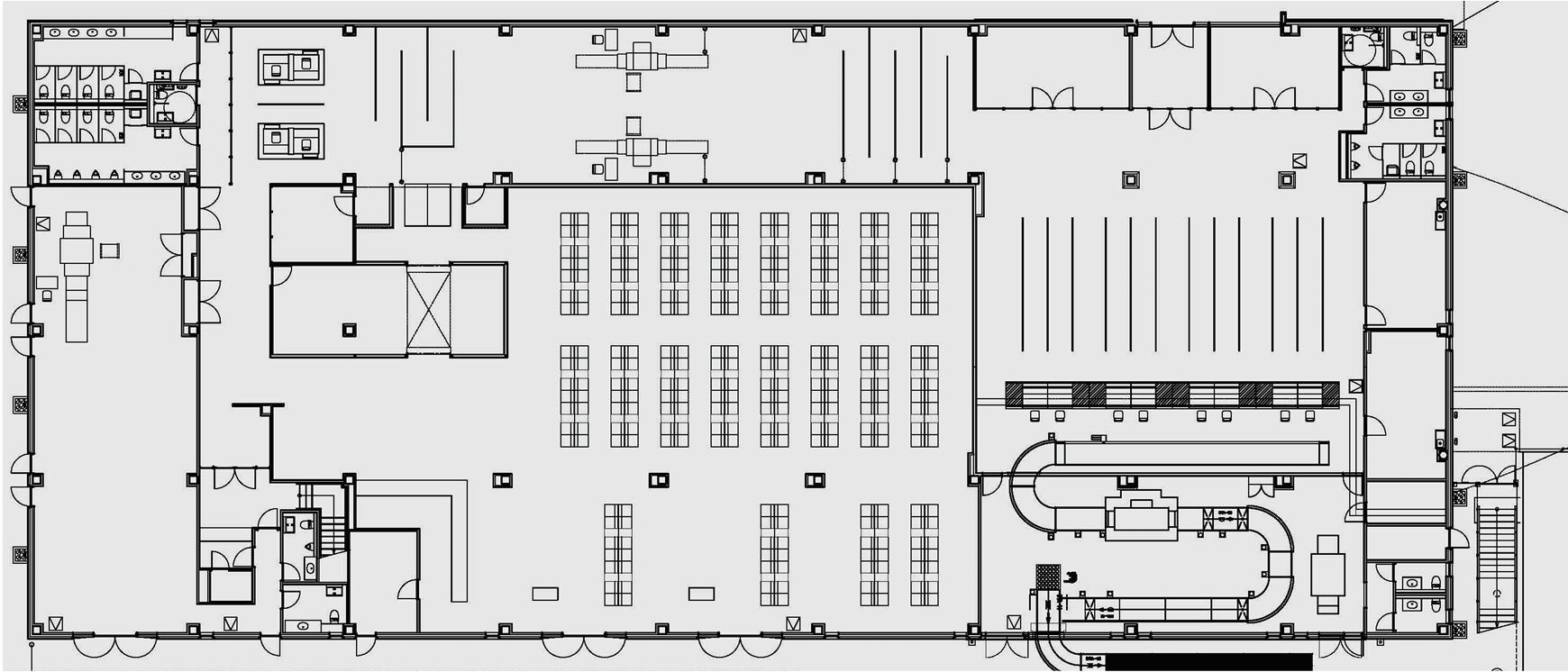
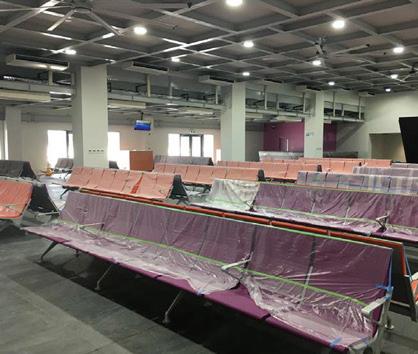


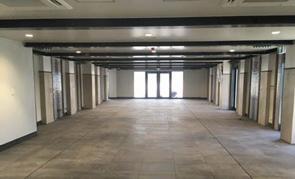
Check-In Hall 1 Shop & Cafe 2 3 Security Area & Immigration Counters 4 5 ② ③ ⑤ ④ ⑦ ① ⑥ ⑨ ⑧ New International Departure Terminal Building 1F Departure Lounge 6 VIP Room 9 Duty Free Shop & Cafe 7 8 > www.pacifictenders.com 13
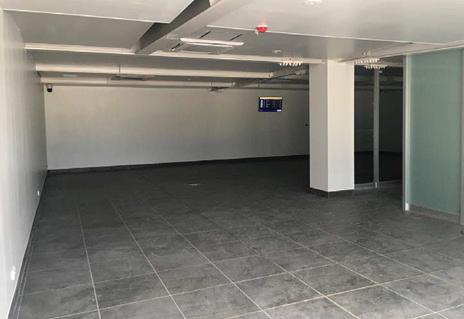


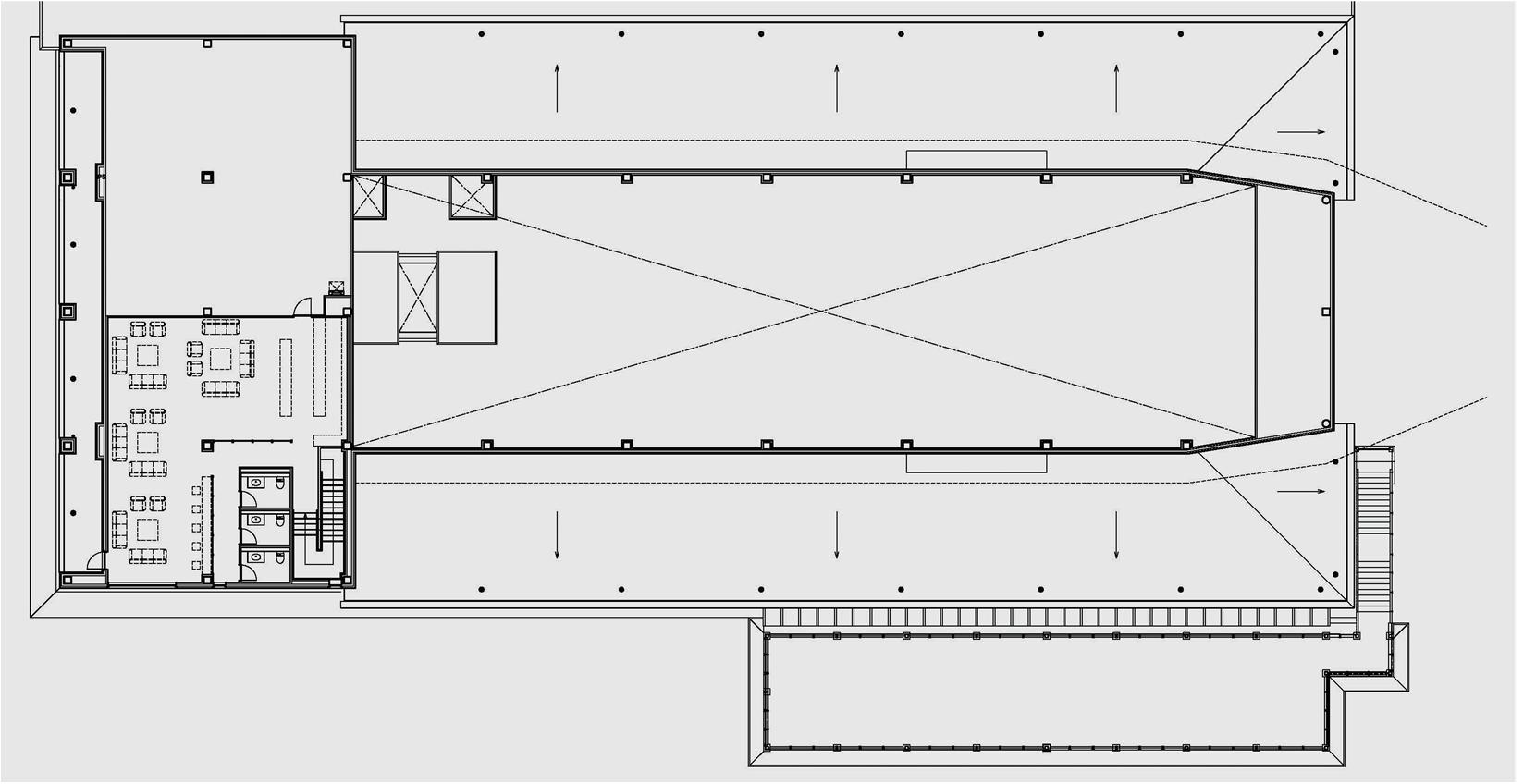

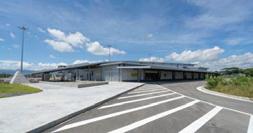
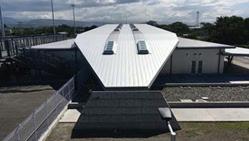
⑫ ⑩ ⑪ Business Lounge 10 Observation Deck 11 Plaza 12 New International Departure Terminal Building 2F and Outside Whole View of the Building www.pacifictenders.com < 14
IUU fishing echoed at the Honiara PNA Summit
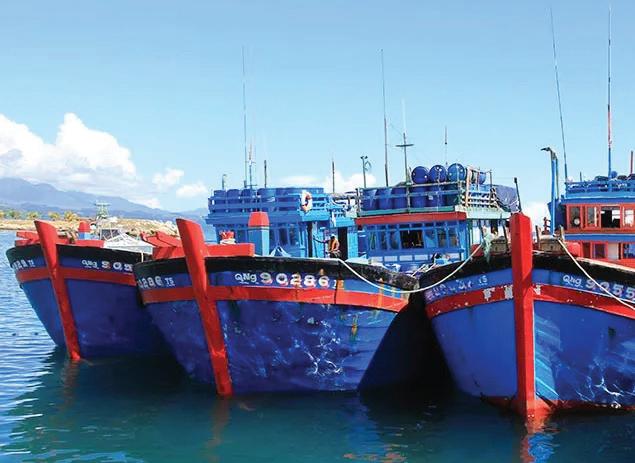

Parties to Nauru Agreement (PNA) Convenes to Ensure Sustainable Tuna Management
THE PARTIES to Nauru Agreement (PNA) has begun its crucial series of meetings this week at the Mendana Conference facility in Honiara, Solomon Islands. The meetings will focus on ensuring the sustainable management of tuna stocks in the region and the effective implementation of the Vessel Day Scheme (VDS).
The VDS was the main topic of discussion during the first day of the meeting. The PNA Technical and Science Committees reviewed technical issues encountered during the implementation of the VDS in 2022, with the outcomes of the discussions set to be presented to the PNA Annual officials meeting scheduled for Thursday, March 16th, 2023.
Additionally, updates on the PNA Fisheries Information Management System (FIMS) were discussed, which helps to monitor fishing activities of vessels within the PNA member’s Exclusive Economic Zone (EEZ). The system captures information on the number of days and locations of fishing vessels, allowing for more effective management of fisheries in the region. The meeting also focused on compliance issues, specifically reporting requirements for vessels operating in PNA EEZ. The PNA officials reviewed the annual report of the organization and discussed the implementation of
the VDS for the year 2022, particularly for Longline and Purse Seine fishing to determine the total allowable effort for 2024.
The PNA committee will continue its meetings, with a focus on the Palau Arrangement. Fisheries delegates from the eight PNA member countries and Tokelau are attending the meeting, underscoring the importance of international cooperation in ensuring sustainable tuna management.
These meetings are crucial to the PNA's ongoing efforts to manage and preserve tuna stocks in the region for future generations.
Group photo after the official opening of the 42nd PNA officials meeting in Honiara, Solomon Islands.
> www.pacifictenders.com FISHING INDUSTRY 15
Three illegal Vietnamese blue boats moored at the Solomon Islands wharf on 29-03-2017. Photo Pacific Guardians
Connect PNG Success Story
A reflection from PNG Minister for Department of Works and Highways HON. SOLAN MIRISIM, MP
connectivity on the economy, the Marape government developed the “Connect PNG” economic road infrastructure development program 2020-2040 in 2020.
Connect PNG aims to both improve the existing roads in poor conditions and also develop new missing link roads, all totalling to 16,000 kilometres. This will open up the country and meet growing demand for road connectivity and increased sustainable road accessibility for development.
The PNG government is taking a long-term view in developing economic lifeline highways and major link roads that responds to future growth and demands of local and national economy. The Connect PNG is a k20 billion worth of long-term program to build economic lifeline highways that responds to future growth and demands of local and national economic development aspirations.
THERE is a strong relationship between Papua New Guinea’s economic development and road connectivity and the quality of roads, as roads play a very vital role in the economic and social development. Since 2014 PNG has had more than 70% of the country’s roads in poor or failed condition due to continuous under funding situation that resulted in k40 billion maintenance bill to the asset owner (the state). This situation added to the ever-increasing transportation and logistics cost and the overall cost of doing business and delivery of public goods and services.
The deteriorated state of the existing roads and the underdevelopment of road connectivity and accessibility is already a huge bottleneck in the progress of government’s goal of diversifying and growing the economy to achieve a PNG Kina 200 billion GDP in 10 years.
Considering the short-term and long-term impacts of the declining conditions of the existing roads and limited road

As a result of the legislative reforms, the implementation of PNG government’s Connect PNG program is now underpinned by the connect PNG (implementation and funding arrangements) act 2021 which gives stable long-term funding commitment of 5.6% of the annual budget, allocated to CONNECT PNG over the 20 years life of program. Using the forward projections for the budget expenditure, this commitment would amount to over k1.3 billion on average per year and will give a total sum of k7.89 billion investment for the 2022-2027 medium-term program period.
Within the legislated 5.6% annual budget funding commitment, the national government has committed to implement 4 main priority programs:
In line with our government’s commitment to boost the capacity, efficiency and productivity of the main economic highways, an allocation of k3.5 billion investment at k700 million per year from 2022-2027 to upgrade and improve 4,200 kilometres of national highways comprising Hiritano highway, Magi highway, Highlands highway, Ramu/Madang highway,
JANUARY - MARCH 2023 / ISSUE 12
www.pacifictenders.com < 16
Wau Bulolo highway, Sepik Coastal highway, Kokoda highway, Bulominsky highway, Enga highway, and Manus highway to international standard 2-lane highways.
Up to 2022, a total of 2,700 kilometers, that is more than 50%, of the highway sections had been upgraded and improved. This include improvement of 85% of the 430 kilometers of the Highlands highway section from nadzab to kagamuga under the adb co-funded highlands highway investment program, 95% of 135 kilometers of Hiritano highway, 70% of 115 kilometers of Bougainville roads, 100% improvement to Bulominsky highway and as well as major improvements on other main highways around the country.
The government will invest k200 million annually commencing 2023 budget and will reach k1 billion in 2027 to construct additional 1,800km to connect 1 million people yet to be connected by road and provide access to unlock economic potential. The priority is to complete and open the missing link section between Aseki and Epo on the trans-island highway by 2025 to meet the government’s short-term goal to open this highway with 50th independence anniversary of our country. For this, we have completed 60% of the 141 kilometres and we expect to complete the 100% by 2025 to coincide with 50th independence anniversary.

All in all, we have recorded some major achievements on the construction of the new missing link roads including;
• Maramuni missing link road-100% open
• Erave - Semberigi - 100% open-connecting the southern to
the norther region
• Baiyer to Madang - 40% opened
• Itape - Vanimo - 100% opened to traffic
• Fisika - Lae - 80% open - will fully open this missing link by 2025
• Central - Milne Bay - 50% open
• Tabubil - Telefomin – 80% open and by September this year
• Missing will be opened fully
• Guimini – Karamui - Gulf - 40% opened
We will continue to complete the remaining kilometres on the current projects and commence on other priority roads. Connect PNG is implemented on the commitment of government to see all roads improved must lead to socioeconomic growth. Accordingly, our rural communities will continue to benefit from k1.5 billion investment to upgrade and improve 9,000 kilometres of sub-national roads in partnership with local authorities. This component will also include major arterial roads for the regional cities of mt. Hagen, Port Moresby, Kokopo and Lae and other major towns to urban road standard in partnership with the municipal authorities to provide opportunities to grow the local economies and encourage investments with improved access to markets, service hubs and industrial centres.
Up to 2022, more than 1,066 kilometres of roads had been improved to ‘good’ condition, that is over 35% achievement.
INFRASTRUCTURE DEVELOPMENT / INDUSTRY > www.pacifictenders.com 17
Up to 2022, more than 1,066 kilometres of roads had been improved to ‘good’ condition, that is over 35% achievement.
We are on track to bring to ‘good’ condition 3,000 kilometres of this sub-program by 2027. K450 million worth of contracts are in progress on the main city roads including k380 million for Lae-Nadzab 4-lane section 2a and 2b, k50 million for Mt Hagen city 4-lane road safety improvement works, k70 million for Lae city concrete standard roads, k20 million for Hagen city roads, k10 million for Kokopo airport road. Under sub-program 4 to upgrade and replace 1,000 metres of overdue bridge structures on the main highways, government is committing a total cost of k1 billion at k200 million per annum between 2023 and 2027. To date we have completed 165 bridges (bridges lengths in meters to be confirmed) out of 2,000 metres target on national highways, we have achieved 591 metres with 71 major bridges on the Highlands highway at design stage. We have supplied and constructed 2,000 metres of bridges for rural roads which already increasing the rural access for the rural population by 20% from what used to be in impassable conditions.
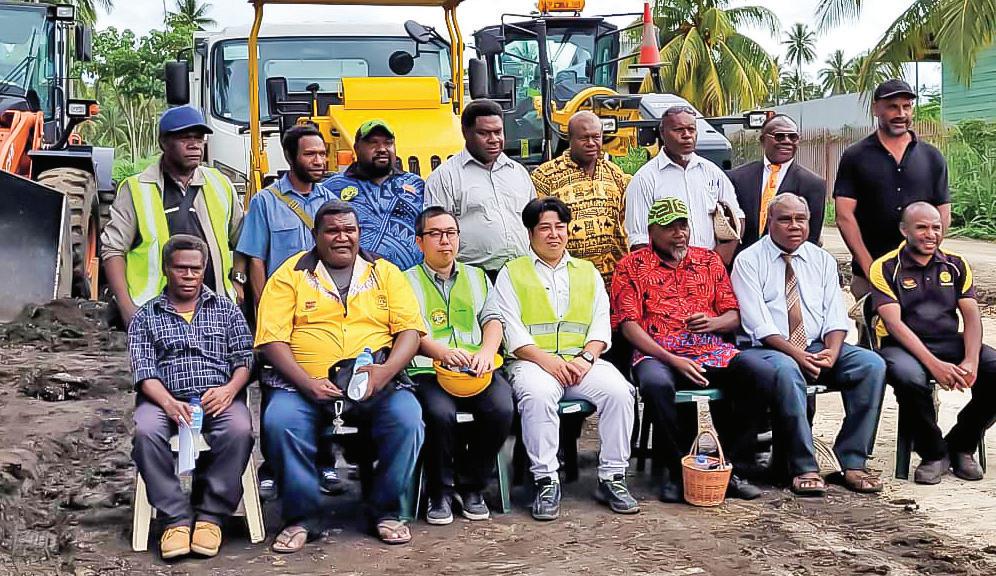
The Department of Works and Highways (DOWH) strives to ensure investment decisions are continued to be made on the basis of proper cost-benefit analysis with appropriate designs to ensure fit-for-purpose engineering standards, environmental standards, safety standards and world best practices are adequately accommodated and reflected in the final results and outcomes. Some of these reforms in the design standards and road building technologies are best practices we adopted are already giving improved results and they include:
1. Pavement recycling and stabilisation technology: 300 kilometres of roads on the main highways had been rehabilitated and stabilised including sections of Enga
highway, highlands highway, Ramu-Madang highway and Lae-Nadzab 4-lane section of the Highlands highway. This technology stabilises and gives longer service life and saves on maintenance cost.
2. Concrete pavement technology: 70 kilometres of Lae city roads have been done using the rigid pavement standards changing the pothole city name into cement city in the last 5 years of continuous effort and work. The concrete pavement gives longer service life at low maintenance cost as they are climate resilient.
3. Shift from project loans to program loans: shifting from project-based loans to programme loans to ensure work continuity on major highway sections. For example, the 430km section of the highland’s highway is now being improved under a 10-year ADB programme financing.
4. Design and build construction contract models: design and feasibility studies are compulsory requirements of the project delivery process to ensure large investments on large highway sections are done with confirmation of technical feasibility and economic viability that delivers high returns on investment.
5. Independent project management: all big projects are now managed by independent project managers who act impartially with high work ethics and practices to ensure projects are delivered to the standards specified in the contracts and of high quality.
6. Long-term maintenance policy: in order to prolong the life of the roads built at high capital costs, we are introducing long-term maintenance programs on the newly improved highway sections. At the end of day, we want to grow
JANUARY - MARCH 2023 / ISSUE 12
www.pacifictenders.com < 18
our GDP through increased economic activities as roads connect investors and developers to natural resources.
Major investments in key roads are already generating the expected returns and benefits. For example, along the corridor of the newly built Lae-Nadzab 4-lane sections is booming with developments along the 4lane highway corridor. Some of the critical impacts and benefits that have been generated out of these improvements in roads and bridges include:
1. 10,000 rural and technical jobs for PNG on construction sites all around the country boosting rural income for PNG families.
2. Creating 20 new small to medium local contractors in direct and sub contract arrangements at a total contract value of k1.2 billion.
3. K600 million worth of royalty and land compensations payments on project sites boosting local economies and increasing household incomes for rural families.
4. 3 hours of travel time savings on the main national highways in proportion to the 50% road condition improvements.
5. K300 million savings in vehicle operating costs from wear and tear on the main highways from improved road conditions.
In responding to one of the long-standing public concerns and interest on the abuse of road maintenance funding, critical achievements have been recorded. Since 2013, department of works and highways has referred all claims to court instead of the usual out of court settlement practices. With the support of the state solicitor, the courts have dismissed false claims and subsequently saved k700 million in total amount. “We will continue to defend any false claims and i inform everyone out there, contractors, claimants and government officials, there is no room for false claims any more under the connect PNG laws that protects abuses and insulates against abuses and misuse of road related funds. The program activities cover the entire country and the benefits as well, both direct and indirect, both immediate and longterm benefits are expected to spread widely. This is the true meaning of ‘leaving no one behind’ in every development effort of this government,” Said the DOWH Minister.
“We have various funding streams including government of PNG concessional loans, grants, tax credit scheme funds, and commercial loans. These various funding streams have their own governance and accountability arrangements. On the same note, i am happy to say that the 5.6% allocation (k1.6 billion) in 2023 will be managed through a dedicated trust account with high level oversight by the NEC-approved wholeof-government connect PNG programme steering committee chaired by the secretary for national planning and monitoring,” The Minister said.
The Connect PNG program is not just mere talk. Since its inception in 2020, more than 230 projects have been procured and implemented under the various sub-programs which i highlighted already. Out of the planned k5 billion budget, we
have procured k3.6 billion worth of projects including a k600 million in arrears payments for legacy contracts inherited from the previous governments.
On the back of our achievements so far, the DOWH will be implementing a massive k5.6 billion worth of road maintenance and capital works contracts representing the biggest road works ever to be undertaken in the history of our country in the next five years 2023-2027.
It is very important to highlight that the connect PNG program is aimed to cover all four regions, all provinces, all districts and communities as its benefits will be spread widely both now and into the future. Of the total k5.152 billion worth of ongoing works, there is k1.7 billion in the highland’s region, k2.01 billion for Momase region, k848 million for new guinea islands regions and k555 million for the southern regions. On the provincial and district roads being implemented in partnership with the provincial and district road authorities. At this juncture, let me acknowledge our development partners who are contributing more than 50% of the capital investment in the connect PNG program with loans and grants funding. They include Asian Development Bank, WB, Australian Aid, Japanese Aid through JICA, Chinese Exim Bank, Australian Infrastructure Financing Facility Loan, oil and Petrol Exporting Countries (OPEC), and Indian Exim Bank. I also acknowledge the private companies that fund projects through the tax credit scheme that include OK Tedi, Exxon Mobil, and New Britain Palm Oil.
Sub-national road authorities are supported by increased funding through the department of national planning and monitoring and technical support from the department of works and highways. Decentralization of technical functions and powers requires proper capacity and resources to subnational authorities is taking place progressively to effectively implement road management and maintenance responsibilities. This transfers across all provinces and districts is important to deliver local road projects effectively and boost local employment and economic activities.
Just in 3 years, connect PNG is progressing very well with massive achievements on the main highways, rural roads, bridges and opening up key missing links to touch the untouched with socio economic impacts that will add value to the major investment costs we are doing.
We are very confident that with the current level of political and funding commitment with strong project management and monitoring efforts, connect PNG will deliver the results in timely manner to transform PNG from a low-income country to an upper middle-income country.
It cannot be ‘business as usual’. Minimum funding commitments made under the law must be made available always to make sure we do not turn back but continue to move forward to achieve “100% road connectivity by 2040 and PNG shall never be the same again. I leave two quotes for us from john.
F. Kennedy
1. ‘it is not our wealth that built our roads, but it is our roads that built our wealth’
INFRASTRUCTURE DEVELOPMENT / INDUSTRY > www.pacifictenders.com 19
Hatanga Teams up with Australian Construction and Dredging Company Hall Contracting
Local construction company Hatanga Limited has announced a partnership with Australian-based firm Hall Contracting Pty Ltd. The Queensland-based company, which has 70 years of experience in construction and dredging, has signed a memorandum of understanding with the Solomon Islands-based Hatanga to collaborate on delivering infrastructure projects in the country. Under the agreement, Hall Contracting will manage all dredging and marine civil works, while Hatanga will oversee landside operations.
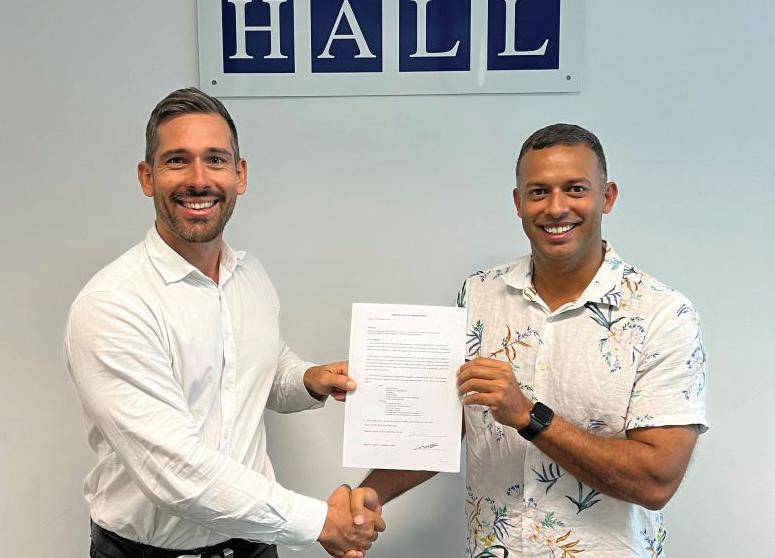
“We’re looking forward to working collaboratively with Hatanga to build high quality, climate-resilient infrastructure,” said Hall Contracting in a statement. They added that the partnership will enable them to create employment and training opportunities for local communities.
Founded in 1946 by Les Hall, Hall Contracting has been involved in climate change projects across the Pacific region. The company specializes in designing and implementing adaptation strategies that improve coastal resilience and reduce vulnerability in Pacific
Island communities.
“Whether it’s building a new seawall in Tuvalu or Tokelau, conducting land reclamation and coastal protection works, undertaking flood mitigation dredging on a Fijian river, or dredging hard clay for a new port facility in Papua New Guinea, Hall Pacific is experienced in delivering dredging and climate change adaptation solutions in the Pacific Islands,” said the company.
In a statement, Hatanga Ltd expressed their privilege to collaborate with Australia’s largest privately-owned dredging, civil, and marine construction company. “In a vulnerable setting like ours in the Solomon Islands that is at heightened risk of climate disasters, we hold with significance the need to deliver quality infrastructure for our people and our communities," the statement said. Hatanga also noted their excitement to learn and grow through the partnership, especially in exposing their local contractors to dredging and marine civil works.
“Thank you very much Hall Contracting Pty Ltd!” the statement concluded.
JANUARY - MARCH 2023 / ISSUE 12
www.pacifictenders.com < 20
Hall Contracting with the signed a MOU with Solomon Islands-based civil construction company Hatanga Ltd.
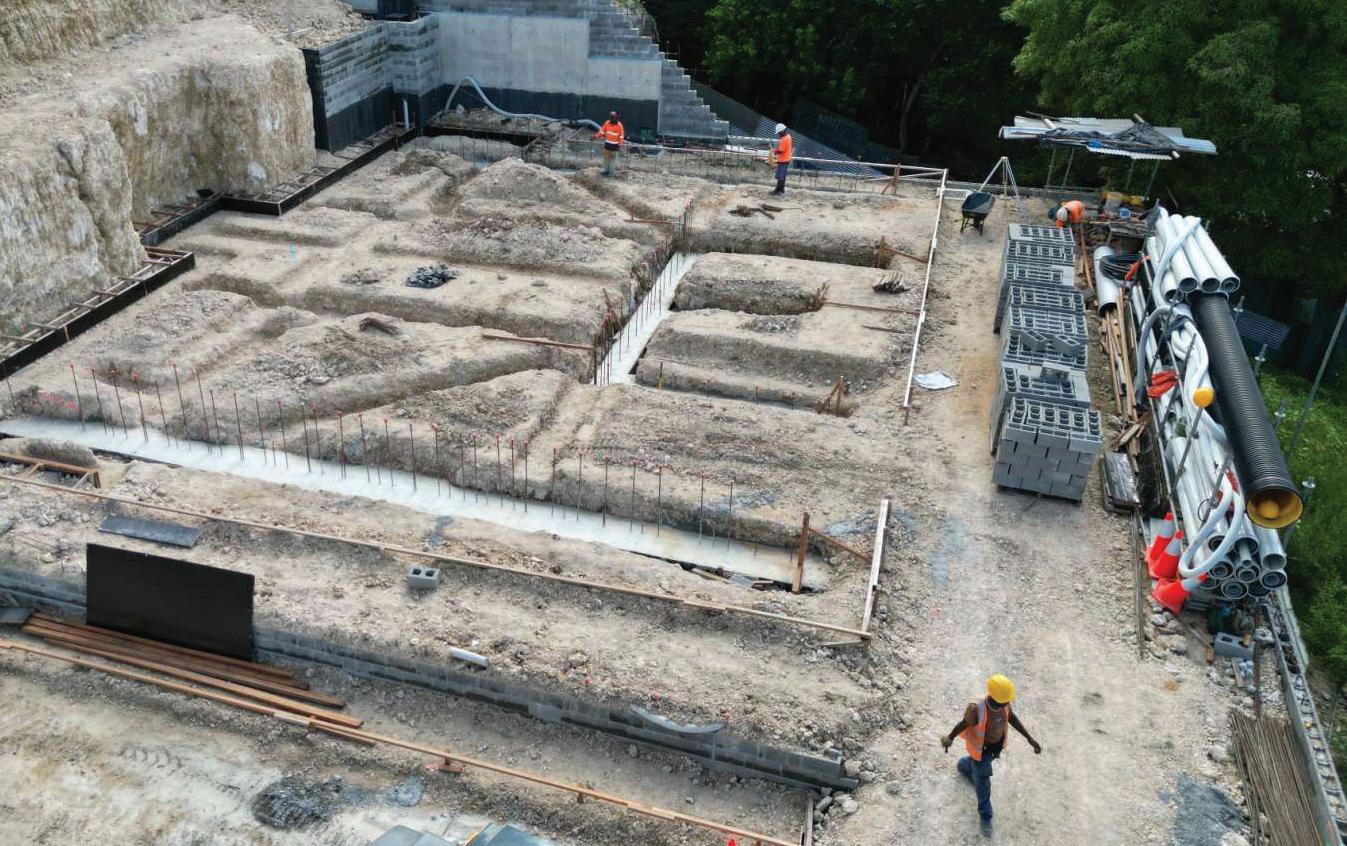
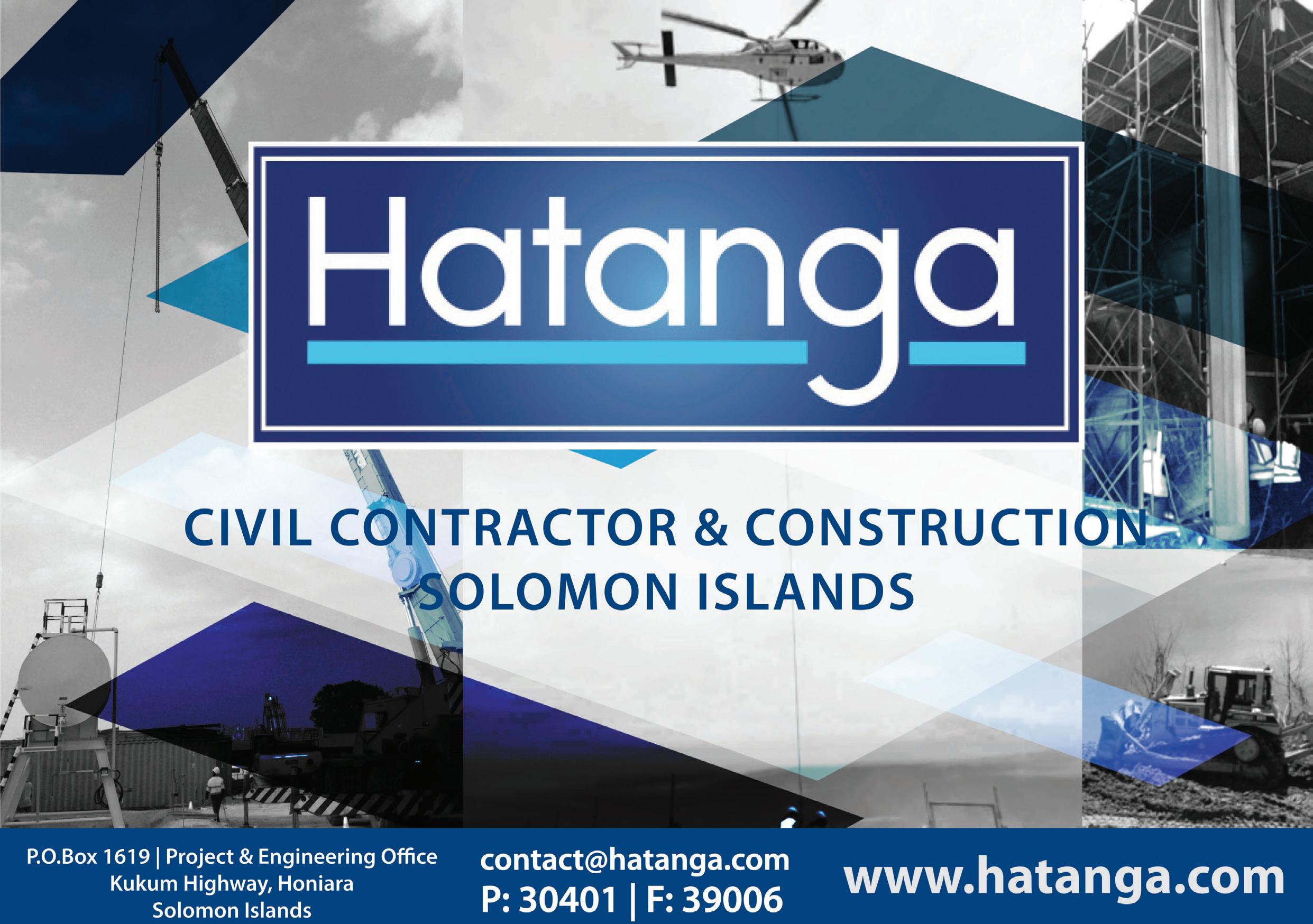
INFRASTRUCTURE DEVELOPMENT / INDUSTRY
Hatanga Group at work at the SINPF project site.
Local Content: Walk or Talk?

“AUSTRALIA walks the talk on local content,” boasted the Australian High Commissioner to Solomon Islands in December 2022. This followed the launch in October of the “Local Content Strategy” for the flagship Australian aid program to Solomon Islands, known as the Solomon Islands Infrastructure Program (SIIP). So called “local content” is enshrined as one of SIIP’s five guiding principles: “Every SIIP-supported investment must be planned, designed, procured and constructed to optimize local content outcomes”
It's hard to argue with the sentiment that if large infrastructure is being funded, it may as well benefit the Solomon Islands businesses in the short term, as well as being a long-term asset investment. The engineering and construction industry is an obvious beneficiary. But what does ‘local content’ really mean – is it another foreigner’s condescension or does it capture a felt need for Solomon Islanders? Let’s dig deeper to see what it means, what it promises, what’s happened so far and whether it can deliver on expectations.
The land of lost content
It is a common complaint that aid projects come and go and leave nothing behind but a wharf, bridge or road. The term “boomerang aid” was coined to describe this phenomenon. Despite the Australian moniker, it’s not just Australia who have engaged in this – Japan, China,
New Zealand have all been guilty of it. To Solomon Islanders, local content means very much what it sounds like – the inclusion of Solomon Islands nationals, their firms, their products, their knowhow, in the development and delivery of infrastructure. A lot of building and construction work happens across the country, with no need for any foreigners to be involved. Why is it that when foreign donors fund a project, it seems to come with a Breakwater café full of foreigners? In the 1990s, Australian funded projects were legally required to give preferential treatment to Australian companies. It seems that the last decade geopolitical escalation has caused an about-face on this policy, amongst others.
Yet, there are three main reasons why low levels of local content persist:
• Complexity of projects – the perception of complexity pushes donors to trust people/companies that they know
• Accountability for Value for Money – Low appetite for donors to break up large projects into smaller chunks for delivery by local firms
• Pressure from donor-country firms – delivering foreign aid projects is a business model for some companies and they apply pressure for that to continue/increase
And so, the “content” goes to firms from the donor’s country. Granted, market forces and common sense
JANUARY - MARCH 2023 / ISSUE 12
www.pacifictenders.com < 22
DAVID SPRING PT COLUMNIST Sydney, Australia
dictate that some local labour, subcontractors and equipment/materials will always be ‘local’. But, the profits are repatriated, along with most of the knowledge.
Going to the local
Efforts have been made under some projects funded by multilateral banks to include ‘local preference’ in the procurement processes. As Solomon Islanders have (rightly) taken more autonomy over the way that aid funding, especially loan funds, are spent in their own country, the push for more overt and reliable local content has increased.
“SIIP Skills Series” is how to develop a GEDSI policy - a key SIIP tender document. Other training is planned in response to future assessments of need. There is a register on the website for local firms who have an interest in partnering with larger regional firms (https://siip.com.sb/industryopportunities/ ). During the tender process, SIIP will use this register to connect local expertise to create “infrastructure partnerships” with the regional firms. Yet, for a flagship aid project spruiking local content, there must be more to it than a few training courses and a register. Indeed, there is.

Enter SIIP. SIIP promises to optimise the local content. How will they deliver this?
There are a few mechanisms in place, each of which is mapped to a stage in the infrastructure lifecycle. These include assessments of contractors/suppliers, capabilities, training needs, training opportunities and existing expertise. As each of the ten or so current SIIP investments are at different stages in their lifecycle, some activities have already commenced. Every two months or so a free skills workshop has been run – the second one rolled out on 1 Feb 2023, addressing contract management. These are intended to improve the ability of local firms to make sense of the contracts they will be asked to sign. The next in this
Joining the bureaucratic dots
As with all good policy implementation, it needs a policy framework. SIIP’s local content policy framework aligns horizontally and triple vertically integrated A, B, C activities that address metrics, targets and actions across 7 key actions, by adopting 12 guiding principles. Simple!
This bureaucratic construct is underpinned by a definitional framework, which defines what SIIP means when they say ‘local content’ (refer Figure 1). This is where the rubber hits the road – the definitional framework sets the ground rules for what will and will not be deemed to constitute the involvement of a local
INFRASTRUCTURE DEVELOPMENT / INDUSTRY > www.pacifictenders.com 23
Figure 1: SIIP definitional framework (Source: SIIP Local Content Strategy)
firm. If you don’t meet the criteria, don’t expect any special treatment.
If you do qualify, it’s not a free ride either. There are further obstacles to your firm’s involvement – there’s an investment framework, which will assess the volume of opportunities on any one project, ranking each project as low, medium or high. If it’s ranked low, there’s a low chance of anything but training and cleaning contracts for locals.
If a qualifying local firm can tick all those boxes, the next hurdle is to consider where the firm fits in the project lifecycle (from concept design through to operation/maintenance). Many local firms are owned by nationalised Chinese. Under the definitions of the policy, those firms could still qualify.
The density of this process and the difficulty of a local firm ever deriving any benefit from it, is a symptom of the difficulty of what SIIP has set out to do – legitimise favouritism within a process that is designed and fiercely defended as being impartial.
Gone walkabout
The strategy document is generally optimistic about the local industry. There are capability assessments within the document demonstrating this. Excepting Noro Port, the planned projects are by no stretch complex projects - market buildings, domestic wharves, runway upgrades and a medical clinic (even if some of the specifications are exacting, e.g., Naha Birthing Centre).
It's the perception that there are a lot of barriers to genuine participation that is at odds with the optimism and opportunity. While the training will be appreciated, it’s difficult to see this local content strategy meeting local expectations. Participation levels are unlikely to exceed what market forces would have delivered anyway. Consider what is already developing with new business partnerships, such as the Hatanga-BY Group partnership PT reported in the last issue (PT Magazine, Issue 11, First Nations First).
From local content to collaboration
Local content is a label, and carries political tones which are hard to ignore. To operate beyond this, perhaps a new style of contracting is required – an “alliance” contract, where all contracted parties (client, donor, contractor, designer) share the financial gain (or pain) for the outcome of the project. This would mean that decisions which necessarily involve the trade-off between quality, time and cost would be taken jointly,
rather that at one party’s expense. An alliance would enable and empower client-side representatives to assure the quality of product supply and placement, while also feeling the pressure of losses incurred during stand-down time or by any rework to achieve that outcome. It would empower designers to innovate and explore options, knowing that savings in construction time or cost are possible, but also that optioneering takes time and money to develop.
Such a contracting mechanism can enable any savings to be reinvested by the client, either in the project or elsewhere. When a situation develops which may mean the project incurs financial or reputational loss, as these losses are shared, there is a vested interest for everyone to share their knowledge and resources to solve for the best outcome.
The governance and legal liabilities of alliances could be difficult to negotiate, considering international laws, loan financing and various other risks. Alliances are touted as being suitable in a ‘mature’ contracting environment, not for every project or contract. But they are ideal for complex environments, fast tracked projects and projects with overlapping risks. A vehicle such as SIIP would be the ideal platform to test this. How does this relate to local content? If increasing local content is important to the client, then in an alliance, that requirement becomes a project indicator with a financial incentive attached to achieving it. Then the project team holds themselves accountable for delivering on it. It is a very powerful set of incentives and governance model.
Walk or crawl?
Alliances are the gold standard. Yet, within the current realities for SIIP, an approach which engages, plans for and designs projects that are intended to be delivered with local firms, expertise and materials would be a success.
The SIIP lens is an Australian lens. It values intended long-term economic outcomes more highly than ensuring the local industry has a reliable supply of work. That is a mistake. The demand side of the infrastructure market should be supported with a consistent, accessible pipeline of work. This will enable companies to invest for the long term, and in doing so, may well achieve political and economic goals at the same time. Perhaps a more appropriate slogan would be “crawling the talk on local content”. Not very elegant, but then, neither are the opportunities for local industry to date.
JANUARY - MARCH 2023 / ISSUE 12
www.pacifictenders.com < 24
Tender Bidding Remedy
Tendering is a process by which companies or organizations invite bids for projects or contracts

Winning a tender in the Pacific region can be a challenging task, as the competition can be intense and the requirements can be strict. However, with the right strategies and approaches, winning tenders in the Pacific can be a viable and profitable option for businesses. In this article, we will explore some of the solutions to winning tenders in the Pacific.
Understand the tender requirements
Before submitting a bid for a tender, it is crucial to understand the requirements of the tender fully. Take time to read through the tender documents and identify the specific needs of the client. This will help you to tailor your bid to meet the specific requirements of the tender, making it more likely to be successful. It is also essential to ensure that your bid complies with all the tender conditions and that you submit it before the deadline.
Build relationships
In the Pacific region, building relationships with potential clients can be a critical factor in winning tenders. Take time to meet with clients, learn about their needs, and build trust. Attend relevant conferences and networking events to meet potential clients and build relationships. This will give you a better understanding of the client's needs and make your bid more relevant and compelling.
Offer value
Winning tenders in the Pacific is not just about providing the lowest price. It is about offering value to the client. Identify what sets you apart from your competitors and showcase
your strengths in your bid. Demonstrate your expertise, experience, and understanding of the client's needs. Show how your solution will provide value to the client and how it aligns with their goals and objectives.
Focus on quality
Quality is essential in winning tenders in the Pacific. Ensure that your bid is well-written, error-free, and easy to read. Make sure that it clearly and concisely presents your solution and demonstrates your expertise. Use graphics, charts, and tables to make your bid more visually appealing and easier to understand. A well-presented bid will demonstrate your professionalism and make you stand out from your competitors.
Be innovative
Innovation can be a key factor in winning tenders in the Pacific. Look for new and innovative solutions to the client's needs, and be creative in presenting your solution. Demonstrate how your approach is unique and how it provides additional value to the client. By showing that you are innovative and forward-thinking, you can differentiate yourself from your competitors and increase your chances of winning the tender.
Winning tenders in the Pacific requires a strategic approach, a focus on quality, and a willingness to be innovative. By understanding the tender requirements, building relationships, offering value, focusing on quality, and being innovative, you can increase your chances of success. Winning tenders can be a profitable option for businesses, and by following these solutions, you can increase your chances of winning tenders in the Pacific region.
HACKS and TIPS > www.pacifictenders.com 25
Tonga: One Year On
DAVID SPRING PT COLUMNIST Sydney, Australia

IN 2014, TONGA was one of the few countries in the world who were creating new land. The Hunga-Tonga-HungaHa'apai volcano lava flows were forming an island, 50km north west of Nuku’alofa, the capital. Just 7 years later, that island is all but gone, obliterated by an eruption on a scale that is experienced around the world only every 12 years. After rumbling on and off for a month, on 15 January 2022 the volcano erupted explosively. By 18 January, the Prime Minister of Tonga declared a state of emergency. The Tongan Government and Tongan Red Cross Society (TRCS) requested international assistance.
The nature of the damage incurred across Tonga’s islands was specific to the natural hazards. Firstly, the volcanic seismic activity damaged the international undersea fibreoptic telecommunications cable between Fiji and Tonga. This hampered information flow in the hours and days that followed. Seismic activity and the resulting tsunami also damaged about 600 residential and non-residential buildings, including nearly every official government building in Nuku’alofa. The volcanic ashfall (15-30mm thick) contaminated water supplies, ruined crops, livestock and affected fisheries and forestry. The result was significant damage to nearly all infrastructure on the west coast of Tongatapu, the Ha’apai island group and the west coast of ‘Eua. Early situation reports indicated that approximately 85,000 people were affected, which is 84% of Tonga’s total population. Sadly, three lives were lost.
The initial damage estimate was USD 90.4m . Later estimates doubled that to USD182 million or 36.4% of Tonga’s GDP. Damage to the internet cable interrupted not only communications but also financial and remittance flows.
In the weeks following this multi-faceted disaster, donors made commitments worth approx. USD 31m. France, China, Fiji and UK sent emergency supplies and humanitarian aid. These figures don’t include the generous and tireless efforts of NGOs and their supporters around the world. It seems that the initial funds provided to Tonga have
been primarily used to simply keep the country running. Along with emergency funding from the IMF, the financing supported balance of payments, clean up and recovery efforts, emergency spending on health care and social protection as well as various ongoing reforms.
In numerous instances, the subsequent recovery funding (beyond the initial USD 31m) has been channelled through existing projects and programs. An additional $US10m was approved for the World Bank’s Tonga Safe and Resilient Schools Project, to continue to improve the resilience of school buildings. The additional funding will fund the reconstruction (to improved resilience standards) of up to 30 school buildings at 12 schools.
The Tonga Climate Resilient Transport Project was signed up on 31 January 2022, just after this disaster event. There is provision within the project for funding a “Contingent Emergency Response” in the event of an eligible crisis, as needed.
The Australian government provided a further AUD 16m of non-specific funding, accompanied by a delivery of 54,990 Pfizer vaccines , to serve the needs aligned with a plan developed by the Tongan government partners’ Hunga Tonga-Hunga Ha’apai Volcanic Eruption and Tsunami Disaster Recovery and Resilience Building Plan 2022-25. Over the past five years, Tonga has faced a string of disasters: Tropical Cyclone (TC) Gita in 2018, TC Harold in 2020 and the damage to the undersea cable in 2019. According to the IMF, Tonga’s fiscal management was quite astute following these three shocks, and a macroeconomic policy buffer was created. This helped it then weather the effects of the pandemic, despite considerable economic losses (GDP contracted 2.7% in FY2021). If anything, this latest disaster should reinforce to Tonga’s government that they are on the right economic track, by continuing the focus on enhancing climate resilience and nurturing the private sector.
As we see with the donor reaction to this event, the funding modalities for disaster funding are changing. Over the past 10-15 years, when disasters have struck Pacific countries, recovery projects have been launched. Such was the case for TC Pam which struck Vanuatu in 2015, TC Winston (Fiji, 2016), even TC Gita in 2018 – multilateral banks used PostDisaster Needs Assessments as the basis for scoping loan
JANUARY - MARCH 2023 / ISSUE 12
www.pacifictenders.com < 26
and grant ‘recovery’ projects. As anyone with a mortgage knows, when your blows down, it’s no joy to have to take out a larger mortgage to rebuild it. If recovery funding can be built into new projects from the start, the financial risks of such borrowings can be considered without the pressure of emergencies. Opportunities to assist with initial recovery efforts are significant for local firms and firms already operating on the ground. Mobilising internationally can be very challenging in the aftermath of an event, making it unusual. It is usually only done through bilateral/military agreements, which excludes contractors except in rare circumstances.

It is only a matter of time before another disaster impacts Tonga. Every effort going in now to improve its infrastructure and economic resilience will help.
 Before and after satellite images of the Hunga Tonga Hunga Ha’apai volcano in Tonga. (Photo: AP)
Before and after satellite images of the Hunga Tonga Hunga Ha’apai volcano in Tonga. (Photo: AP)
INFRASTRUCTURE DEVELOPMENT / INDUSTRY
National Building Codes the Catalyst to Quality Assurance
PT MAGAZINE had the privilege to interview Mr. Ishmael Alulu, the Deputy Director of the Ministry of Infrastructure Development Quality Assurance and Quality Control (MIDQC) Department. During the interview, Mr. Alulu provided valuable insights into the function and operations of the MIDQC team.
The team is part of the Ministry's TRANSPORT INFRASTRUCTURE MANAGEMENT SERVICES Division and is responsible for ensuring the quality and safety of infrastructure development projects across the country. In this issue, we explore the MIDQC team's story, their role in maintaining the country's transport infrastructure, and the challenges they face in carrying out their mandate. Quality assurance for materials used in the construction industry is a crucial aspect of ensuring that buildings are structurally sound and safe for their occupants.
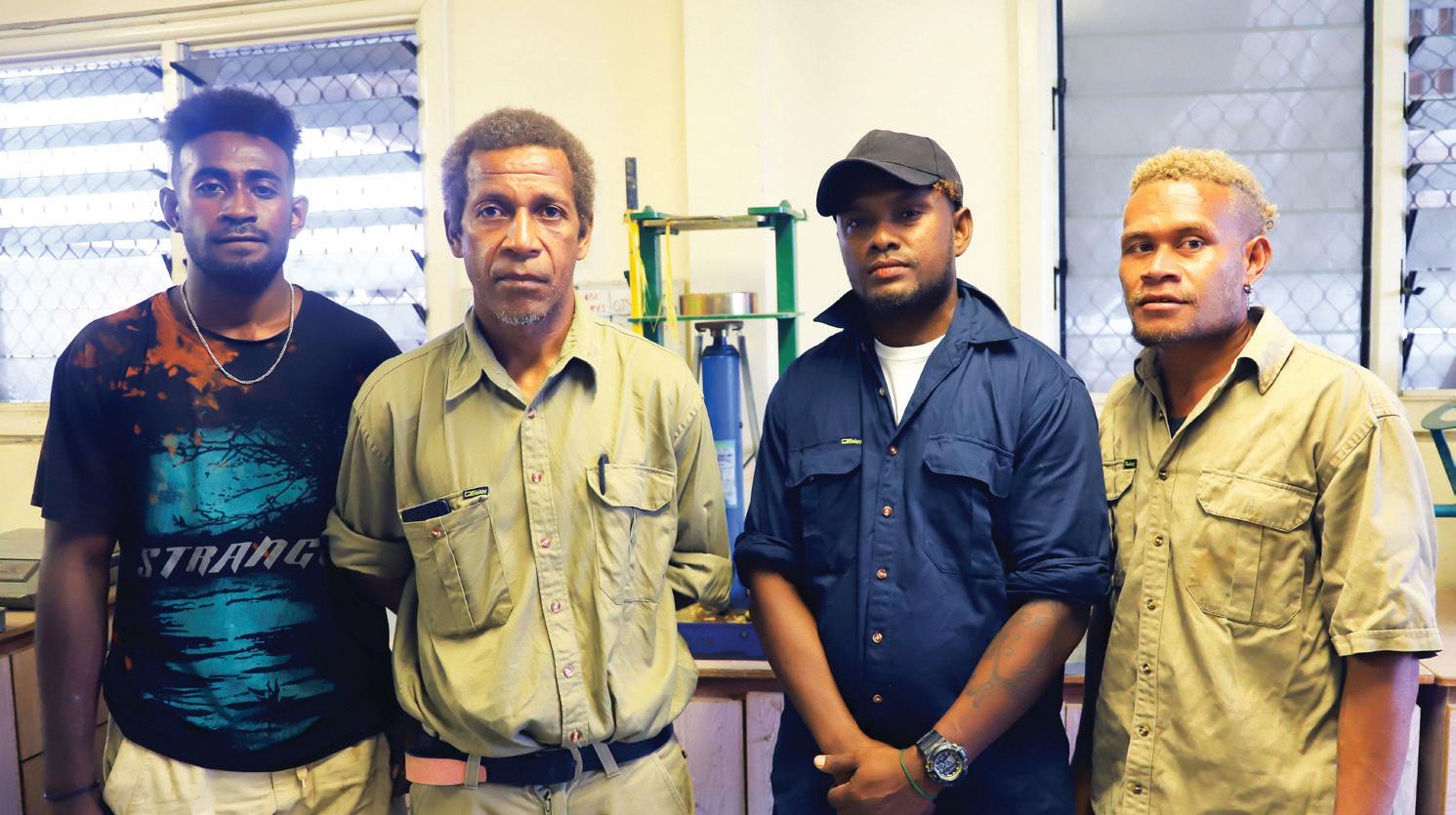
In Solomon Islands, there are many quality construction materials available, such as hardwood timbers, bamboo, basalt gravel, sand gravel, lime stone, and water. However,
the biggest issue facing the construction industry is the lack of quality control measures and enforcement. Without proper testing and quality control, there is no way to check the bearing strength of erected structures or ensure that structures are safe and reliable. This lack of oversight can lead to dangerous and potentially fatal accidents, as well as a lack of confidence in the construction industry. To address these issues, the Solomon Islands government Ministry of Infrastructure Development has been working to enact and implement new building codes that will enforce quality assurance and quality control measures for all construction materials. This will help to standardize quality material supplies, such as bricks, aggregate, timber, concrete, and steel, and ensure that all building projects meet a minimum standard of safety and reliability. The Ministry of Infrastructure Development Construction Material Laboratory (MIDQAC) is the implementation agency of the National Building Code. The laboratory is staffed by professionals with expertise in civil engineering,
www.pacifictenders.com < 28
Ishmael Alulu, second from left with Lab technicians
geology, and structural quality control, and is responsible for testing and verifying the quality of building materials. However, the laboratory needs quality improvements and competent staff technical training to ensure that it meets international standards. To facilitate the NBC, the Solomon Islands government needs to establish a highly certified international NATA standard operating QAC unit. MIDQAC itself needs funding to perform internationally.


Once the building codes are gazetted and enforcement mechanisms are in place, the MIDQAC team will be responsible for ensuring that all building standards and quality assurance measures are met. This will involve improving their quality standard performance to NATA standards, ensuring that building inspectors are properly trained and qualified, and enforcing regulations on all building permits.
Before seeking a building permit, contractors must take into consideration the quality and safety of the materials they plan to use, as well as the structural soundness of their proposed designs. Building inspectors play a crucial role in ensuring that all construction projects meet these standards, and the MIDQAC team works closely with HCC inspectors to ensure that all building projects are safe and reliable.
The construction industry in Solomon Islands has a lot of
potential to thrive, but quality assurance and quality control measures must be put in place to ensure that all building projects are safe and reliable.
By enacting and enforcing building codes, improving the quality of testing and inspection facilities, and properly training staff, Solomon Islands can build a thriving and sustainable construction industry that provides safe, reliable, and high-quality buildings for its citizens.

The MIDQC team based at the MID headquarters in Honiara is responsible for:
1) QUALITY ASSURANCE ACTIVITIES
* Materials investigation for material properties for infrastructure design.
* Implementation of assurance documents –Building code, Spec, Drawings, manuals, methods & Calibrations/ competency
2) QUALITY CONTROL (CONSTRUCTION MATERIALS LABORATORY)
* Materials construction laboratory for construction materials
* Construction materials quality control checks.
Clockwise from top:
- Concrete Compression - Lab Technician, John Misitana.
- Sieve analysis - Lab Technician, Henly Ramo.
> www.pacifictenders.com 29
- Lab Technicians - DCP Field test.

JANUARY - MARCH 2023 / ISSUE 12 www.pacifictenders.com < 13
Ministries ready to implement Safe and Green Games
GOVERNMENT MINISTRIES are now ready to implement the Safe and Green Games in their Ministerial Budgets, following the launch of the Safe and Green Games Strategy by the Hon. Prime Minister, Manasseh Sogavare on 3 March 2023.

Permanent Secretaries and Deputy Secretaries have completed their briefing on the implementation of the Safe
and Green Games Strategy last Thursday.
Chair GIC, in the Office of the Prime Minister and Cabinet, overseeing Government Preparations for the Pacific Games 2023, Bernard Bataanisia, says the meeting enabled Ministries to be briefed on the implementation of the work plan and activities and align to the Safe and Green Games Strategic Plan under the four (4) Pillars.
> www.pacifictenders.com 31
1. Beautification and Landscaping
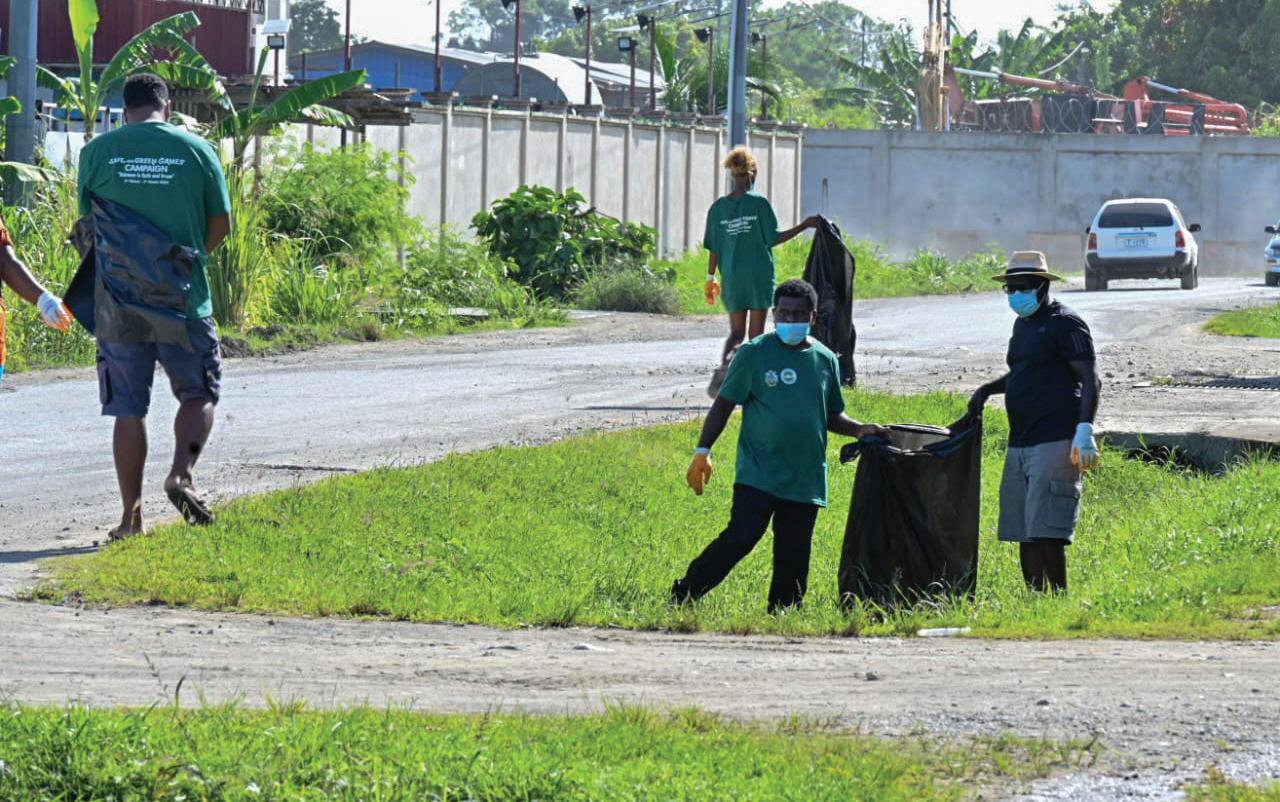
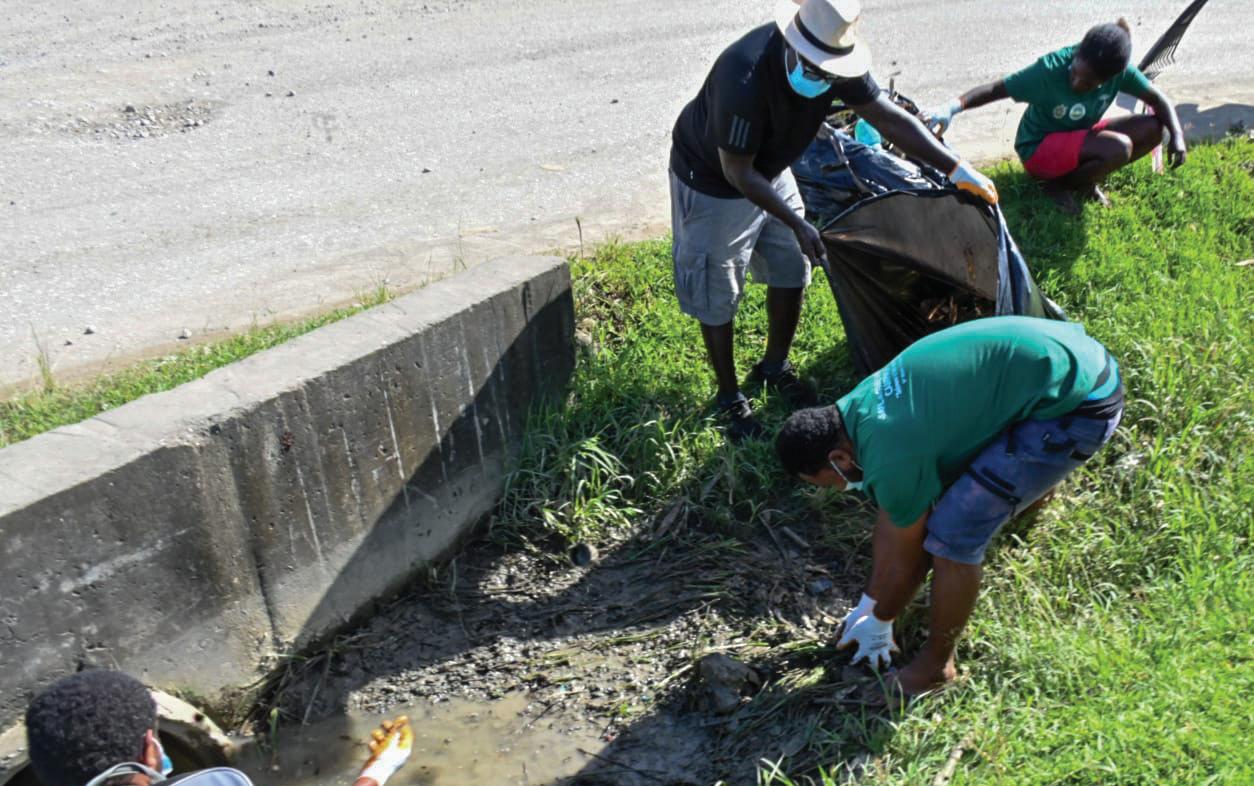
2. Games Critical
3. Games Support
4. Advocacy and Awareness
The Chairman added that each of the Ministerial activities and work plans are dovetailed under the above Pillars and support NHA and GOC to successfully implement the Games. The Chairman further added that during the meeting, Permanent Secretaries and Senior Officials were introduced to GSIC Secretariat Team based at NHA, who will work with Ministries in the implementation of their work plans and activities. The CEO of GOC Peter Stewart updated the meeting on key functional areas required from Government services to support the Games. These include Health, Security, Border Control and other services.
Finally, Government Officials during the meeting shared lessons learnt from the City Wide Cleanup campaign on the 4th and 5th March. While the Clean-up program has been successful, there were also gaps and challenges faced such as picking up of Rubbish and allocation of Bins in the City, which the Government and HCC are sharing resources to improve.
PG2023 FOOTBALL TRAINING FIELD
THE NATIONAL Hosting Authority of the 2023 Pacific Games Facilities Committee is pleased to announce the progress made towards the development of the PG2023 Football Training Field and the replacement for the former Solomon Islands Football Federation (SIFF) Academy. The project was co-funded by the government and people of Papua New Guinea, the Government and people of Japan, with support from the Solomon Islands government. The funding is coordinated and channelled through the Sports Solomon Funds. The Sports Solomon Funds is a funding mechanism that has been established to support the hosting of the games, and it is managed by the National Hosting Authority (NHA).
The Solomon Islands Government, through the Sol2023 National Hosting Authority, is grateful for the support towards the development of the Pacific Games 2023 Football training field/SIFF Academy. The project, which includes a Multi-Purpose Futsal Court, an office and administration building, a dormitory, two soccer playing and training fields, a changing room, and a beach soccer
field, is set to be completed in August 2023, ahead of the PG2023 opening ceremony in November.
JED Enterprise, a local construction company, is constructing the project, providing job opportunities for locals and building the capacity of local engineers and construction workers. The project is the largest SIG project given to a local contractor.
Most of the construction work is progressing well, with civil works and levelling completed. The superstructure for the Futsal building is also close to completion. The Futsal building/court at the SIFF Academy will give a boost to the development of the sport in the country.
Solomon Islands, as a footballing nation, is blessed with the football facilities that will be available for use by youths preparing for the PG2023 and for many years to come. The passion for football keeps the young people of the Solomon Islands competitively engaged in this sport, and the general populace continues to cheer them on.
JANUARY - MARCH 2023 / ISSUE 12
www.pacifictenders.com < 32
Participants of the campaign cleanning around Honiara.
ACHIEVING HIGH QUALITY, EMBRACING GAMES LEGACY
THE CONSTRUCTION of a natural turf field for the 2023 Pacific Games presents our country with the challenges of keeping the turf to meet Football and Rugby International standards. This means our country must have trained local personnel to manage the turf by having the right type of grass and fertilizer to grow the turf and the right equipment to maintain the fields in preparation for PG2023 and beyond the Pacific Games.
As part of ensuring the maximum impact on the Sol2023 Games legacy the National Hosting Authority engaged Regional Turf expert Mr. Laurie Stubbing as a consultant to advise and guide the NHA and Games Facilities Committee on the development of natural turf to meet rugby and football fields international standards in time for the 2023 Pacific Games from the 19th November to 2nd December 2023.
The NHA contracted the New Zealander given his vast knowledge, experience and his distinguished track record of successful turf works within many countries across the region.
Since his engagement, Mr. Stubbing, has been training a local Turf Assistant Mr. Dickson Ramota Riikwao who has been working closely with him and together are working closely with the contractors to ensure the natural grass fields that are prepared for the 2023 Pacific Games meet the required international standards.
NHA has is preparing the country to manage the fields post games by ensuring that turf works is enhanced with the support of proper machinery are procured including: Seed spreader, Chemical Sprayer, a Tractor with


specialized attachment’s, A specialized Baroness Mowing machine used for turfs and other smaller support tools for occasionally maintaining the turf.
The venues are still under the responsibility of the contractor until they are handed over to NHA after completion at around end of July 2023. NHA is therefore pleased that the contractor is willing to share information as part of building local capacity.
Sol2023 NHA Communications

> www.pacifictenders.com 33
Power Protection Industries delivers customised



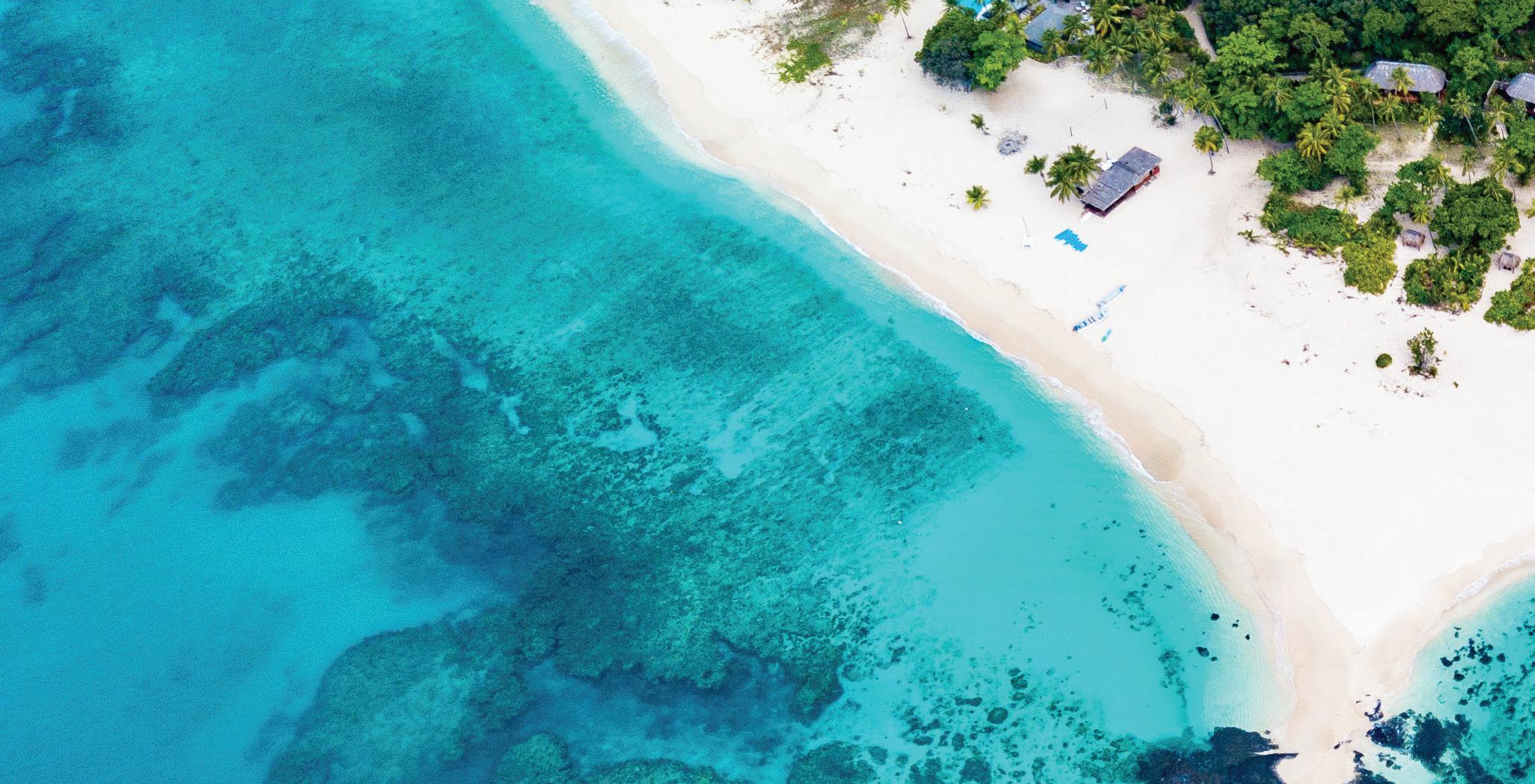
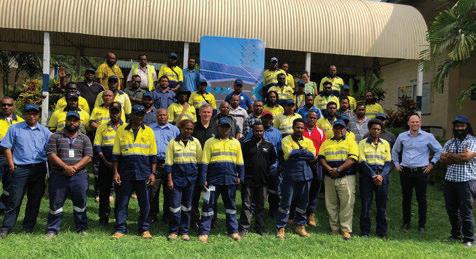

We o er a wide r a ng e of world-l e adi ng p r od u ct s



› Li n e h a r d wa r e
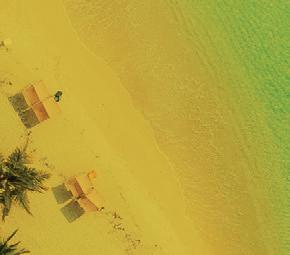
› E art h i ng sol u tio n s
› F us e s

› I n s u la t o r s a n d s u r g e ar r es t o r s
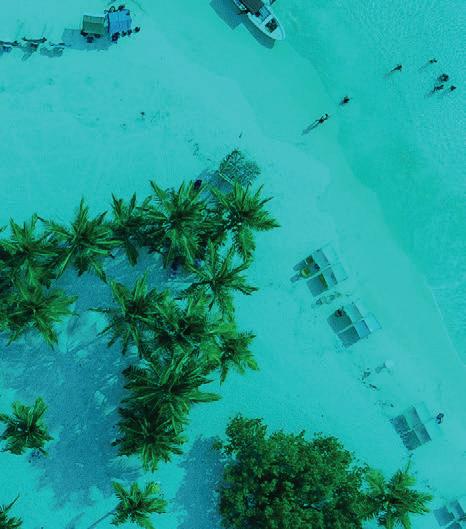

› Tr a ns f or m e r s



Call: +61 7 3734 715 | Email: sales@ppindustries.com.au ww w. pp i n d ust r i e s. com . a u R E N E WABL E E N E R G Y F E A SIBILI T Y ST U D Y
ty solution s for e n e rgy u tilitie s E ARTHI NG S Y ST E M D E SI G N S UB S T ATIO N E ARTHI NG A U DIT S LI G HTNIN G P R O T E CTION A U D I T S R E N E WABL E E N E R G Y D E S IG N O u r ex p ert ser v i ce s
High-quali

























































 Before and after satellite images of the Hunga Tonga Hunga Ha’apai volcano in Tonga. (Photo: AP)
Before and after satellite images of the Hunga Tonga Hunga Ha’apai volcano in Tonga. (Photo: AP)









































